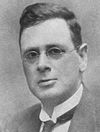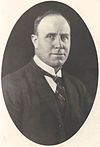
The United Australia Party (UAP) was an Australian political party that was founded in 1931 and dissolved in 1945. The party won four federal elections in that time, usually governing in coalition with the Country Party. It provided two prime ministers: Joseph Lyons (1932–1939) and Robert Menzies (1939–1941).
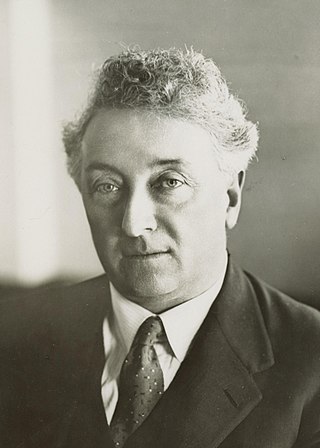
Joseph Aloysius Lyons was an Australian politician who was the tenth prime minister of Australia, in office from 1932 until his death in 1939. He began his career in the Australian Labor Party (ALP), but became the founding leader of the United Australia Party (UAP) after the Australian Labor Party split of 1931. He had earlier been 26th premier of Tasmania from 1923 to 1928.

Francis Michael Forde was an Australian politician who served as the 15th prime minister of Australia from 6 to 13 July 1945, in a caretaker capacity following the death of John Curtin. He was deputy leader of the Australian Labor Party (ALP) from 1932 to 1946 and is the shortest-serving prime minister in Australia's history.

James Henry Scullin was an Australian politician and trade unionist who served as the ninth prime minister of Australia from 1929 to 1932. He held office as the leader of the Australian Labor Party (ALP), having briefly served as treasurer of Australia during his time in office from 1930 to 1931. His time in office was primarily categorised by the Wall Street Crash of 1929 which transpired just two days after his swearing in, thus heralding the beginning of the Great Depression in Australia. Scullin remained a leading figure in the Labor movement throughout his lifetime, and was an éminence grise in various capacities for the party until his retirement from federal parliament in 1949. He was the first Catholic, as well as the first Irish-Australian, to serve as prime minister.

The Third Bruce ministry was the 18th ministry of the Government of Australia. It was led by the country's 8th Prime Minister, Stanley Bruce. The Third Bruce ministry succeeded the Second Bruce ministry, which dissolved on 29 November 1928 following the federal election that took place in November. The ministry was replaced by the Scullin ministry on 22 October 1929 following the federal election that took place on 12 October which saw Labor defeat the Coalition. That election also saw Bruce lose his own seat of Flinders; no sitting Prime Minister would lose his own seat again until 2007.

The Scullin ministry (Labor) was the 19th ministry of the Government of Australia. It was led by the country's 9th Prime Minister, James Scullin. The Scullin ministry succeeded the Third Bruce ministry, which dissolved on 22 October 1929 following the federal election that took place on 12 October which saw Labor defeat Stanley Bruce's Nationalist–Country Coalition. The ministry was replaced by the First Lyons ministry on 6 January 1932 following the federal election that took place in December which saw the United Australia Party defeat Labor. As of 2022, it remains the most recent government to have lost an election after a single term in office.
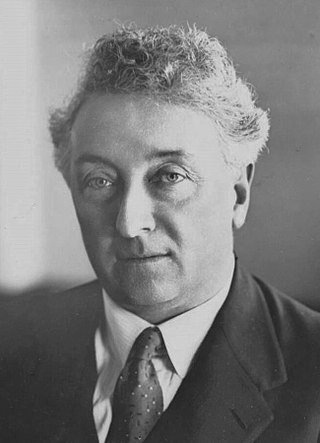
The Second Lyons ministry was the 21st ministry of the Government of Australia. It was led by the country's 10th Prime Minister, Joseph Lyons. The Second Lyons ministry succeeded the First Lyons ministry, which dissolved on 12 October 1934 following the federal election that took place in September. However, it was a minority government relying on support from the Country Party in order to remain in office. The ministry was replaced by the Third Lyons ministry on 9 November 1934 after Lyons entered into a formal Coalition with Earle Page and his Country Party; the second such coalition after that of the Bruce government.

The Third Lyons ministry was the 22nd ministry of the Government of Australia. It was led by the country's 10th Prime Minister, Joseph Lyons. The Third Lyons ministry succeeded the Second Lyons ministry, which dissolved on 9 November 1934 after Lyons entered into a formal Coalition with Earle Page and his Country Party; the second such coalition after that of the Bruce government. The ministry was replaced by the Fourth Lyons ministry on 29 November 1937 following the 1937 federal election.

The Fourth Lyons ministry was the 23rd ministry of the Government of Australia. It was led by the country's 10th Prime Minister, Joseph Lyons. The Fourth Lyons ministry succeeded the Third Lyons ministry, which dissolved on 29 November 1937 following the federal election that took place in October. The ministry was replaced by the Page ministry on 7 April 1939 following the death of Lyons - the first of three occasions where a sitting Prime Minister died in office.
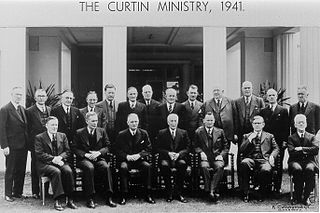
The First Curtin ministry (Labor) was the 29th ministry of the Government of Australia. It was led by the country's 14th Prime Minister, John Curtin. The First Curtin ministry succeeded the Fadden ministry, which dissolved on 7 October 1941 after the independent crossbenchers Alexander Wilson and Arthur Coles withdrew their support for the Fadden government. The ministry was replaced by the Second Curtin ministry on 21 September 1943 following the 1943 federal election.
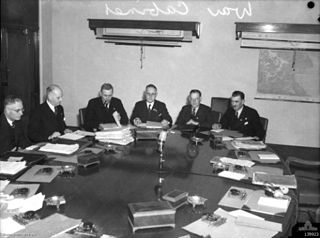
The Second Curtin ministry (Labor) was the 30th ministry of the Government of Australia. It was led by the country's 14th Prime Minister, John Curtin. The Second Curtin ministry succeeded the First Curtin ministry, which dissolved on 21 September 1943 following the federal election that took place in August. The ministry was replaced by the Forde ministry on 6 July 1945 following the death of Curtin - the second of three occasions where a sitting Prime Minister died in office.

The First Chifley ministry (Labor) was the 32nd ministry of the Government of Australia. It was led by the country's 16th Prime Minister, Ben Chifley. The First Chifley ministry succeeded the Forde ministry, which dissolved on 13 July 1945 following the election of Chifley as Labor leader after the death of former Prime Minister John Curtin. The ministry was replaced by the Second Chifley ministry on 1 November 1946 following the 1946 federal election.

Australia suffered badly during the period of the Great Depression of the 1930s. The Depression began with the Wall Street Crash of 1929 and rapidly spread worldwide. As in other nations, Australia suffered years of high unemployment, poverty, low profits, deflation, plunging incomes, and lost opportunities for economic growth and personal advancement.

Lang Labor was a faction of the Australian Labor Party (ALP) consisting of the supporters of Jack Lang, who served two terms as Premier of New South Wales and was the party's state leader from 1923 to 1939. It controlled the New South Wales branch of the ALP throughout most of the 1920s and 1930s. The faction broke away to form separate parliamentary parties on several occasions and stood competing candidates against the ALP in state and federal elections.

James Edward Fenton was an Australian politician. He is notable for having been appointed a cabinet minister by two governments of different political complexions, but resigning from both governments on matters of principle. His first resignation looms largely in history as that came with his political defection, whereas there was no defection with his second resignation.

The 1931 Australian federal election was held on 19 December 1931. All 75 seats in the House of Representatives and 18 of the 36 seats in the Senate were up for election.

John Joseph Daly was an Australian lawyer and politician who served as a Senator for South Australia from 1928 to 1935. He was a member of the Australian Labor Party until 1934, when he was expelled. During the Scullin government he was the party's Senate leader, and held ministerial office as Vice-President of the Executive Council and briefly as Minister for Defence.

Charles Ernest Culley CMG was an Australian politician. He was a member of the Australian Labor Party (ALP) and served in the Australian House of Representatives (1928–1931) and Tasmanian House of Assembly (1934–1948). He was an assistant minister in the federal Scullin government and later became a minister in the Tasmanian state government.

The Lyons government was the federal executive government of Australia led by Prime Minister Joseph Lyons. It was made up of members of the United Australia Party in the Australian Parliament from January 1932 until the death of Joseph Lyons in 1939. Lyons negotiated a coalition with the Country Party after the 1934 Australian federal election. The Lyons government stewarded Australia's recovery from the Great Depression and established the Australian Broadcasting Corporation.

The Australian Labor Party held a leadership election on 2 March 1931, in the context of the developing party split. Prime Minister James Scullin was easily re-elected, defeating Jack Beasley of the Lang Labor faction.











